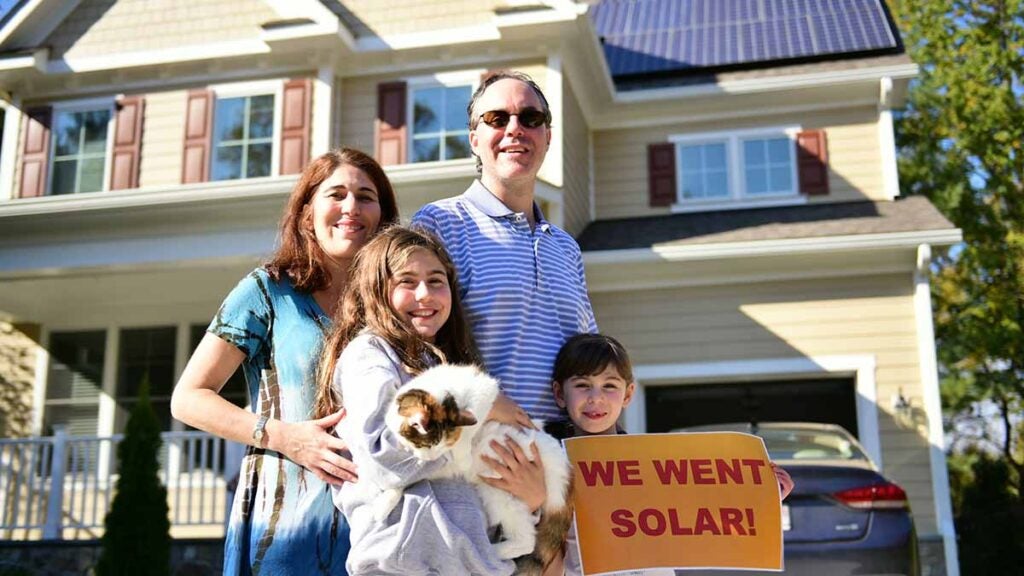Going solar checklist: 7 steps for choosing and installing solar panels on your home

If you’ve been thinking about adding solar panels to your roof, you likely already know at least two things about it:
- The benefits of going solar are great for you and for your community, and
- There’s a lot to figure out and make happen before you can start producing your own electricity!
This checklist outlines the seven steps it takes to go solar, giving you the confidence you need to get started — and get installed!
Download our Go Solar GuideStep 1: Learn about solar
The first step in going solar is to get familiar with the technology, economics, and installation process.
If you’re like most people, you have questions like:
- How many solar panels will it take to power my house?
- How much power does a solar panel produce?
- How much do solar panels cost?
- How long do solar panels last?
Our Go Solar Guide and other free resources will answer all of these questions and more. As an installer-neutral nonprofit, we provide expert-level knowledge without any pressure to purchase.
We also recommend asking around in your community. Your neighbors who have installed solar panels will have great insight and be excited to help others do the same. Or, if you prefer to learn alongside others, see if there’s a free solar co-op in your area.
Step 2: Research installers
Solar companies — also called solar installers — operate in every part of the country, from Alaska to Puerto Rico. They’re so abundant that it can be hard to narrow down which installers might be right for you. The company you choose should be one that meets your needs and preferences for price, access to the latest technologies, sound business practices, and more. Ask your friends or neighbors who they worked with, look at online reviews, and always be cautious of solar scams.
Step 3: Get three proposals
Proposals from solar installers should give you all the information you need to make a decision with confidence. It should tell you:
- How large your solar array is
- Where on your roof you should install panels
- What the parts of your solar system are
- How much your solar system will cost
- How much energy your solar system will produce
- How long it will take you to go solar
We recommend requesting a custom solar proposal from at least three solar installers.
Step 4: Compare the offerings
Compare the proposals you’ve received, keeping in mind how they meet your specific needs and preferences. Not everyone needs the same solar system. For example, maybe one installer charges more, but the other two don’t offer the type of equipment you want for your system. Being able to see and compare three proposals will inform how you think — and what questions you ask — about your preferred installer’s process.
While SUN is installer-neutral (in other words, we don’t recommend particular installers over others), we help people review their proposals all the time. Reach out to our Solar Help Desk for help clarifying anything on your proposals.
Step 5: Choose an installer
Select the installer whose proposal best meets your needs. Ask them for further information or clarification if needed before signing a contract with them.
Step 6: Sign a contract
Once you’ve selected your installer and you’re satisfied with their proposed project details, it’s time to sign a contract so they can start the installation.
Like most legal documents, solar contracts can be lengthy and full of jargon. But be sure to read yours thoroughly. Everything should be as you expected, reflecting what you and your installer have discussed thus far. If there’s anything unfamiliar in your contract, ask about it. If you see anything that raises suspicion, contact SUN for guidance.
Step 7: Get installed!
Once your contract is signed, your installer will start ordering your system equipment, applying for local permits, and then installing your panels. In most cases, the actual installation of a solar system takes just 1–2 days. (Of course, additional time may be required if you’re replacing your roof or electrical panel.)
Once your system is installed in your home, it may take some time for your installer to connect the system to the electrical grid, depending on your municipality’s approval process.

